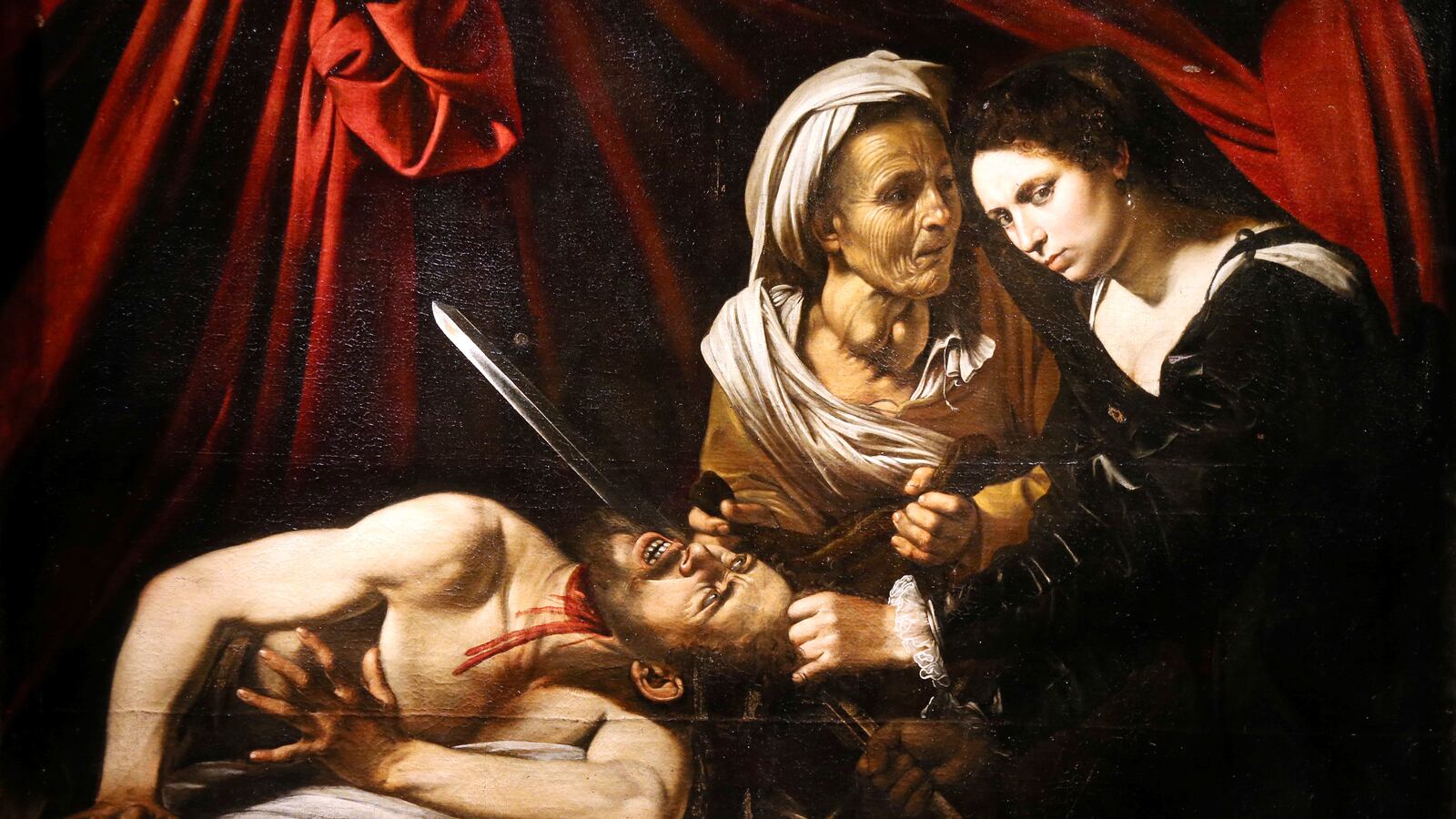PARIS — It was a benign search for the source of a leaky roof that brought the French homeowners face-to-face with the stunningly gruesome painting entombed Cask of Amontillado-style in a sealed area of their attic in Toulouse. Depicting a grisly beheading, the large painting would have made for a questionable fixture in a living room or bedroom, which could explain why it had been locked away and forgotten in the attic.
However, it’s not the painting’s graphic nature that has the art world abuzz. On Tuesday, two years after the surprise discovery in Toulouse, French art experts announced that the man behind the canvas was none other than Michelangelo Merisi, better known as Caravaggio, and that the gory scene, “Judith beheading Holofernes,” is a Baroque masterpiece thought to have been painted between 1600 and 1610.
“This particular lighting, this energy typical of Caravaggio without corrections, with a sure hand and the pictorial material mean this painting is authentic,” art expert Eric Turquin told reporters during a press conference on Tuesday, adding that the painting could be worth as much as €220 million ($250 million).
Caravaggio scholar and former director of the Naples museum, Nicola Spinoza, backed Turquin: “One has to recognize the canvas in question as a true original of the Lombard master, almost certainly identifiable, even if we do not have any tangible or irrefutable proof,” Spinoza wrote in an expert assessment.
However, other art connoisseurs have expressed doubt about the painting’s authenticity, including renowned Caravaggio specialist Mina Gregori, who told Le Quotidien de l'Art that although she recognized the “undeniable quality of the work,” a genuine Caravaggio it is not.
Moreover, while Caravaggio is known to have painted two versions of Holofernes’s grisly end at the hands of biblical heroine Judith—one is on display in Rome’s Galleria Nazionale d’Arte Antica—he was not the only artist to depict the Babylonian general’s final moments.
Some experts speculate that Louis Finson, a Flemish painter and art dealer who copied Caravaggio’s works and owned several of his paintings, could be the man behind the “Caravaggio in the attic,” while others suggest that Finson owned Caravaggio’s second version of “Judith Beheading Holofernes.” One scholar said that it may have been because of Finson that the masterpiece ended up in France.
“He spent several years in France on his way home, and this new picture turned up in Toulouse,” John Gash, a Caravaggio scholar and senior lecturer at Scotland’s University of Aberdeen, told The Daily Beast in an email. “I wouldn’t rule it out as the original of the work, previously known through a copy in Naples.”
He added: “The other possibility is that it, too, is a copy, perhaps by Finson himself, since he was a keen businessman and dealer.”
The painting’s gory subject matter, bizarre discovery, and the subsequent disagreement it has created among art historians seem fitting given the legend that continues to tail the controversial master more than 400 years after he succumbed to a fever at the age of 38. Or died by lead poisoning. Or was murdered by the Knights of Malta.
Apparently scholars haven’t been able to reach a consensus on that subject either. And although tales of his drunken antics, scuffles with the authorities, and death sentence for murder are legendary, verifiable details surrounding Caravaggio’s life are nebulous at best. Centuries later, the man continues to fascinate.
“People are drawn to the myth of a bohemian, anti-social, at times violent outsider who channeled the complexities of his own nature into an assertively iconoclastic, hyper-realistic art,” said Gash.
And although Baroque’s enfant terrible may no longer be here to stir up trouble, his paintings continue to generate controversy in the modern age. Just a couple of years ago, the high-end auction house Sotheby’s was the subject of a lawsuit after it sold what it believed to be a copy of Caravaggio’s “The Cardsharps” for £42,000 ($60,000) only to have the purchaser declare it an original and value it at £10 million ($14.2 million). Naturally, the original owner was less than pleased, and sued Sotheby’s for failing to see the painting’s potential. The judge ruled in favor of Sotheby’s.
And in 2012, the apparent discovery of some 100 Caravaggio sketches in a Milanese castle was widely reported in the media. However, aside from a rash of headlines immediately after “the find,” there was no further news about the sketches in the years that followed.
“These sketches were neither discovered, nor by Caravaggio,” Sybille Ebert-Schifferer, the director of Rome’s Bibliotheca Hertziana and author of Caravaggio: The Artist and His Work, told The Daily Beast in an email. “They stem from the workshop of Simone Peterzano, Caravaggio’s teacher.”
As for the painting in the attic, experts will continue to examine it in the coming weeks in hopes of being able to attribute it definitively to the late great master. The French government has even slapped an export ban on the painting, saying in an official statement that “Every effort is being made to confirm its precise origin. The painting deserves to be retained on French territory as a very important landmark Caravaggio painting.”
In the meantime, it may be worth cleaning out your attic.






